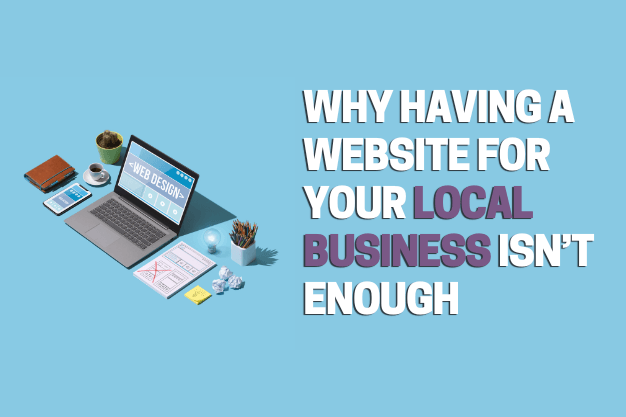It’s no secret that nowadays having a website for your local business is essential—but if you think that simply having a website is enough, you’re missing the bigger picture. Your website might be the face of your business online, but it’s just one piece of the puzzle. To truly thrive in a competitive market, you need to go beyond just having a website. It’s about leveraging that site as part of a broader, more dynamic digital strategy that connects with your audience, drives engagement, and builds lasting relationships. Let’s dive into why a website alone isn’t enough and what you can do to elevate your online presence.
The Website: A Good Start, But Not the Endgame
A well-designed website is a great starting point. It provides a digital storefront where potential customers can learn about your products, services, and values. But in a world where consumers are increasingly expecting more personalized and interactive experiences, a static website simply won’t cut it.
Think of your website as a business card. It’s necessary, but it doesn’t do much on its own. Just as you wouldn’t rely solely on handing out business cards to grow your business, you shouldn’t rely solely on your website. To truly engage customers and stand out in a crowded market, you need to build a more comprehensive online presence.
The Power of Content: Engaging Beyond the Homepage
One of the most common mistakes local businesses make is treating their website as a static entity. It’s easy to think that once it’s live, your work is done. However, a stagnant website can quickly become outdated, irrelevant, and ultimately ignored by both search engines and potential customers.
Content is king, and your website should be a living, breathing part of your marketing strategy. Regularly updated content keeps your audience engaged, improves your search engine rankings, and positions your business as an authority in your industry. Consider starting a blog that addresses common customer questions, shares tips related to your industry, or highlights success stories from your local community.
For example, let’s say you run a local HVAC service. You could publish seasonal guides on home maintenance tips, energy-saving strategies, or detailed explanations of when it’s time to replace an air conditioning unit. This kind of content not only drives traffic to your website but also positions your business as the go-to expert in your community for HVAC needs.
Local SEO: Making Sure You’re Found
A website without proper search engine optimization (SEO) is like a shop without a sign—people might walk by, but they won’t know you’re there. Local SEO is crucial for ensuring that your business appears in search results when potential customers are looking for services or products in your area.
Optimizing your website for local search means more than just inserting a few keywords here and there. It involves a strategic approach that includes claiming and optimizing your Google Business Profile, using location-based keywords, and ensuring your business’s name, address, and phone number (NAP) are consistent across all online platforms. Local SEO also involves garnering positive reviews, which not only boost your rankings but also build trust with potential customers.
Imagine you own a local pest control service. By optimizing your website and Google Business Profile for terms like “reliable pest control in [Your Town],” “termite inspection near me,” or “24/7 emergency pest services [Your Town],” you increase the chances that people in your area will find your business when they need urgent help.

Social Media: Driving Traffic and Building Relationships
Your website might be the cornerstone of your online presence, but it shouldn’t exist in isolation. Social media platforms like Facebook, Instagram, and LinkedIn are crucial for driving traffic to your website and building relationships with your audience.
Social media allows you to engage with your customers on a more personal level, share updates in real-time, and drive people back to your website for more detailed information or to make a purchase. It’s also a fantastic way to showcase your brand’s personality, tell your story, and create a community around your business.
Take a local landscaping company for example. You could use Instagram to showcase before-and-after photos of your work, highlight customer testimonials, and share tips for maintaining a beautiful yard. These posts create a connection with potential clients who may be inspired to visit your website to learn more about your services or request a quote.
Email Marketing: Staying Top of Mind
While your website provides a wealth of information, email marketing is what keeps your business top of mind for customers. An effective email marketing campaign can drive repeat visits to your website, promote special offers, and keep your audience informed about what’s happening in your business.
Building an email list allows you to send personalized, targeted messages directly to your customers. Whether it’s a monthly newsletter, a special promotion, or a personalized recommendation, email marketing is a direct line to your customers that can drive traffic to your website and increase sales.
For instance, if you own a local auto repair shop, you might send out a quarterly email with seasonal maintenance tips, exclusive discounts on services, and reminders for regular vehicle check-ups. This approach not only drives traffic but also helps build a relationship with the customer, making them more likely to return to your site and your shop in the future.
Online Reviews: Building Trust and Credibility
In the digital age, word of mouth has gone online, and online reviews have become a critical component of your business’s reputation. While your website can provide information about your products and services, online reviews offer social proof that others have had positive experiences with your business.
Encouraging satisfied customers to leave reviews on Google, Yelp, and other platforms can significantly impact your business’s credibility and attractiveness. Positive reviews not only improve your local SEO but also influence potential customers who are researching your business.
Consider a local veterinary clinic. By featuring customer testimonials on your website and encouraging pet owners to leave reviews on platforms like Google, you can build trust and provide potential clients with the confidence they need to choose your clinic over others.
Paid Advertising: Boosting Visibility
Relying solely on organic traffic can be a slow process, especially in competitive markets. Paid advertising, such as Google Ads or social media ads, can give your website the visibility it needs to attract new customers quickly.
Targeted ads allow you to reach specific demographics, locations, and even interests, ensuring that your message gets in front of the right people. For local businesses, this can be especially powerful, as you can tailor your ads to reach people in your immediate area who are most likely to need your products or services.
Imagine you own a local custom furniture shop. By running targeted Google Ads that showcase your bespoke pieces, you can attract customers searching for “handmade furniture [Your Town]” or “custom dining tables near me.” These ads can lead directly to a landing page on your website featuring your most popular designs, encouraging visitors to explore more and ultimately make a purchase or contact you for a custom order.

Integrating It All: Creating a Cohesive Digital Strategy
Having a website is important, but it’s only the beginning. To truly thrive, local businesses need to integrate their website into a broader digital strategy that includes content marketing, local SEO, social media, email marketing, online reviews, and paid advertising. Each element of this strategy should work together to drive traffic, build relationships, and convert visitors into loyal customers.
Your social media profiles should link back to your website, your emails should encourage recipients to visit specific pages, and your online ads should lead to well-optimized landing pages. By creating a cohesive digital strategy, you turn your website from a static placeholder into a dynamic hub of engagement and sales.
Elevating Your Local Business Beyond the Website:
In today’s competitive market, simply having a website isn’t enough. Your website should be the centerpiece of a much larger digital ecosystem, designed to attract, engage, and convert customers. By leveraging content, SEO, social media, email marketing, online reviews, and paid advertising, you can create a powerful online presence that drives real results.
It’s time to elevate your local business beyond just having a website. Take action today by integrating these strategies and watch your online presence grow into a dynamic force that not only reaches more customers but builds lasting relationships within your community.

